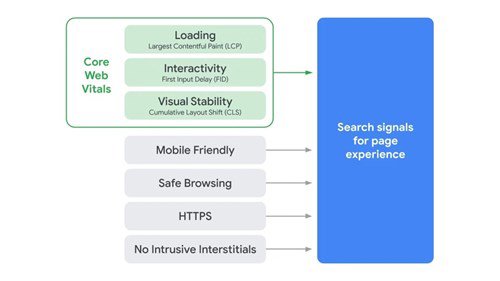Algorithm update “Page Experience Ranking” rolling out in June ’21
In November 2020, Google announced the roll out of the 'page experience ranking signal’. This means that your website Core Web Vitals will have an impact on Google’s ranking. The gradual rollout of this update will start mid-June 2021 (newest roll-out date).
But no need to worry, Google ensures it will be a gradual roll out, and won't be done all at once. Page experience signals, retrieved from Core Web Vitals will be added as a new factor that Google’s algorithm will use next to all the other signals. This is shown in the image below provided by Google.
What are the three Core Web Vitals?
The core web vitals are a set of signals related to loading time, responsiveness and visual stability. These signals will contribute to measuring user experience on websites.
- Loading - LargestContentful Paint (LCP) - this metric measures the time between the start of page loading and full render of the largest element on the screen.
- Interactivity - First Input Delay (FID)-this metric measures the time from the first visitor’s interaction (e.g. link click) to browser's response to that interaction.
- Visual Stability - CumulativeLayoitShift (CLS) - this metric is the score of all unexpected layout shifts within the viewport (during a page’s entire lifecycle).

Source: developers.google.com
What does this mean for your website?
Core Web Vitals will become a ranking factor as of mid-June 2021. This doesn’t mean a big shift in rankings right away. However, its importance will grow over time so it is highly recommended to start your optimisation process now.
Especially because it’s quite time-consuming, technically-complex and might mean quite significant changes need to be made to your website’s template.
Here are some examples of issues that can hurt your rankings:
- Embedding social media posts in your content (as opposed to including screenshots which can decrease loading time 10x) Layout shifts caused by some elements in the navigation (e.g. icons)
- Long-running JavaScript functions blocking visitor’s interactions
- Images or ads with undefined dimensions that push the loaded content away
How can you prepare yourself?
1. Comply with the existing page experience ranking signal (grey area of image above)
- Mobile friendly
- Safe browsing
- HTTPS
- No intrusive interstitial
2. After having these fixed: Take a look at your sites current Core Web Vital scores in Google Search Console.
- If you haven’t set this up yet, don’t wait any longer and do so. We can help you with this. Because Google needs to gather a few days of data in order to compile a report.
- If you cannot wait; check live performance per url with: Chrome Lighthouse Tool.
3. The Core Web Vital Report will group URLs with the same issue on page experience.
- Benchmark your metrics according to the following per metric according to the following benchmark.
- Start with debugging first the issues with a poor score, then Needs improvement.
- Not sure what to do next? We can help you or your development department debug the issues step by step.
Source: support.google.com
Why is user experience getting more important?
You simply can’t deny that the digital world is looking in one very human direction. All the signals indicate a strong trend: customer centricity & empathy.

Source: Google Trends
It’s a no brainer that Google rolls out this update.
Their mission is to answer humans’ questions as fast and seamless as possible. Page experience plays a crucial part. In previous updates, Google already added a variety of user experience criteria (like mobile friendliness, safe browsing etc.)
This Google update is another signal to pressure websites owners to step up their game in user experience. Just by following Google’s requirements businesses won’t get far. It’s much bigger than that.
Keeping up with the UX demands is a must to stay afloat. Exceeding customers’ expectation puts you in a competitive position.
